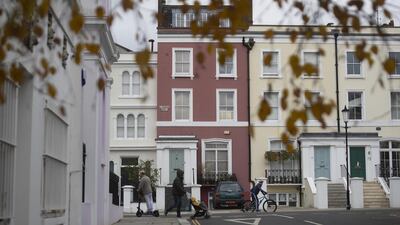British mortgage approvals soared to their highest level in 13 years in November when most of the country was in lockdown, while consumer borrowing showed a record annual decline, according to the Bank of England.
UK lenders approved 104,969 mortgages in November – the highest level since the financial crisis . Unsecured lending to consumers was 6.7 per cent lower than in November 2019, the biggest fall since monthly records began in 1994.
“This was the highest number of approvals since August 2007 and recent strength in approvals has almost fully offset the significant weakness earlier in the year,” the Bank of England said.
The UK property market experienced a surge over the summer on the back of pent-up demand following the first lockdown at the height of the pandemic that shuttered the sector, and UK finance minister Rishi Sunak's tax break.
The Stamp Duty Land Tax holiday, which offers buyers savings of up to £15,000, expires on March 31.
Despite the pandemic, there were 715,300 house purchase approvals up to November, close to the same number over the same period in 2019.
Ruth Gregory, senior UK economist at Capital Economics, said the sharp rise in the number of new mortgages in November, up from the 98,338 in October, leaves approvals 43 per cent above their pre-crisis level.
“At the very least, stronger household balance sheets should mean that there is plenty of scope for household spending, and GDP (gross domestic product), to rebound strongly once the restrictions are eventually lifted,” she said.
However, mortgage lender Nationwide expects the market to slow this year when the tax break expires in March, despite house prices rising 7.3 per cent in December to record their biggest annual increase in six years.
The strength in the housing market contrasts sharply with the wider economy, which is battling falling output and rising unemployment, with Nationwide saying the outlook for prices this year is highly uncertain.
Meanwhile, unsecured lending to consumers continued to fall at a record pace, as many Britons reined in spending during the November lockdown when non-essential retailers, as well as bars and restaurants, were closed across most of the country.
Net consumer lending dropped by £1.539bn in November, a decline of 6.7 per cent from November 2019 and the biggest drop since monthly records began in 1994.
“Households' reduced ability to consume during November’s lockdown meant that they repaid £1.5bn of unsecured loans. Admittedly, that was a less rapid deleveraging than during the lockdown in March 2020 when households paid back £3.1bn,” said Ms Gregory.
While borrowing reduced, household deposits surged by almost £18bn, potentially providing fuel for consumer spending once restrictions are lifted.
The UK economy could grow by 8 per cent in 2021 – the highest jump since the Second World War – partly driven by spending from consumers who have built up £200bn in savings during the Covid-19 lockdowns, according to the Centre for Economics and Business Research.
Meanwhile, non-financial corporates borrowed an extra £2bn from banks in November, a huge decline on the £31bn they added to their debt pile at the height of the crisis in March.
“It was largely small businesses that were still scrambling for cash. They borrowed an additional £1.8bn from banks in November, compared with borrowing of £0.2bn by large businesses,” said Ms Gregory.
Separately, UK manufacturing recorded its strongest growth since 2017 in December on the back of stockpiling ahead of the end of the Brexit transition period on December 31.
The IHS Markit/CIPS manufacturing Purchasing Managers' Index (PMI) for December rose to 57.5 from November's 55.6, its highest level since November 2017 and slightly above an initial flash estimate of 57.3.
Anything above 50 on the manufacturing activity gauge indicates growth, while a reading under that level means contraction.

The latest reading showed factories rushed to complete work before the end of the post-Brexit transition period on December 31, as manufacturers stockpiled materials at the fastest rate since March 2019 amid fears of disruption to trade with the EU.
There were delays at British ports throughout December, with lengthy queues forming at Dover just before Christmas after France shut the border following the identification in Britain of a new mutant strain of coronavirus.
Rob Dobson, IHS Markit director, said he did not expect December's manufacturing surge to last.
"Customers, especially those based in the EU, brought forward purchases, boosting sales temporarily. It seems likely that this boost will reverse in the opening months of 2021, making for a weak start to the year," he said.
In the eurozone, manufacturers also ended 2020 on a high, with activity in the sector increasing at its fastest pace since mid-2018.
Germany was the driving force, and in contrast to the bloc's dominant service industry, the area's manufacturing PMI rose to 55.2 in December from November's 53.8.


